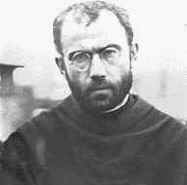Maximilian Kolbe
Martyr
d. 14 August 1941
‘I want to die in place of this prisoner ‘
 FOR MILLIONS the bleak
image of the gates of the Nazi extermination camp at Auschwitz-Birkenau have come
to symbolize an age of genocide. The commemoration of one Christian man who died
there, in light of the destruction of five million Jewish lives between 1941-5, may
give us reason to hesitate. But Maximilian Kolbe, who died as prisoner 16770
in Auschwitz-Birkenau, is much remembered in the Christian Church. He offered
his own life to save a fellow prisoner, Franciszek Gajowniczek, condemned to death by
the camp authorities after a successful escape by a fellow prisoner.
FOR MILLIONS the bleak
image of the gates of the Nazi extermination camp at Auschwitz-Birkenau have come
to symbolize an age of genocide. The commemoration of one Christian man who died
there, in light of the destruction of five million Jewish lives between 1941-5, may
give us reason to hesitate. But Maximilian Kolbe, who died as prisoner 16770
in Auschwitz-Birkenau, is much remembered in the Christian Church. He offered
his own life to save a fellow prisoner, Franciszek Gajowniczek, condemned to death by
the camp authorities after a successful escape by a fellow prisoner.
Kolbe was born on 8 January 1894 in Zdunska Wola. His parents were devout and nationalistic. At the age of eighteen he went to Rome to study philosophy and theology. In October 1917 he and six other students formed a new body, Militia Immaculatae, which promoted a powerful cult of the Virgin Mary, worked to secure converts and to perform good works.
Kolbe returned to Poland to lecture at the Fransciscan seminary at Cracow. In October 1927 Prince Jan Drucki-Lubecki gave to the movement a plot of land near Warsaw to develop their work: this became Niepokalanow, the city of the Immaculatae. Here the community flourished, publishing prolifically, and soon its influence spread across Poland. Its journal was not uncontroversial. A number of issues contained antisemitic articles, but they were not written by Kolbe himself, and he was known to censure the other editors for such work.
In 1930 Kolbe travelled with four of his brothers to Japan, to Nagasaki. There they bought a second plot of land, formerly a cemetery for untouchables. They built a house there and published another journal, provoking curiosity and interest in the city.
Six years later Kolbe returned again to Poland. By now Niepokalanow was producing nine journals with huge print runs. Kolbe viewed it not as a business, but as ‘a modern workshop of the improvement of man’. When war broke out, he sent his brothers away, but remained there himself. He was soon interned. He resisted pressure to apply for release, but was for a time free. He was detained again. At Auschwitz he was known discreetly to give his own food to other prisoners, even as his own health crumbled, to hear confessions and, in the face of stern prohibitions, to celebrate mass. It was late in July 1941 that a prisoner in his own block escaped, and now Kolbe stepped forward to make his sacrifice.
In the starvation cell six of the ten who had been selected died within two weeks. Kolbe was still fully conscious when, on the eve of the Assumption of Mary, 14 August 1941, he was killed by lethal injection.
The cell where he died is now a shrine. Maximilian Kolbe was beatified as Confessor by Paul VI in 1970, and canonized as Martyr by Pope John Paul II in 1981. His image may be found in churches across Europe.
Maximilian Kolbe is one of ten 20th century martyrs whose statues may be found on the west front of Westminster Abbey in London. These are intended to represent all those others who have died (and continue to die) in similar circumstances of oppression and persecution. They are drawn from every continent and many Christian denominations. They include victims of the struggle for human rights in North and South America, of the Soviet and Nazi persecutions in Europe, of religious prejudice and dictatorial rule in Africa, of fanaticism in the Indian subcontinent, of the brutalities of the Second World War in Asia and of the Cultural Revolution in China. The statues were unveiled by the Archbishop of Canterbury, in the presence of H.M. The Queen, H.R.H. The Duke of Edinburgh and church leaders and representatives from many parts of the world on 9 July 1998.
Acknowledgements:
Text adapted from Westminster
Abbey
Image from Sacred Heart